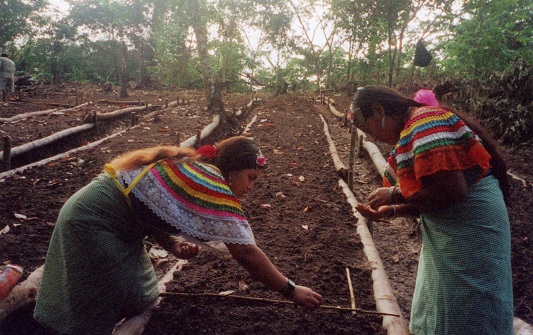From the Rio Conventions’ Ecosystems Pavilion: It is now widely recognized that climate change, land degradation and biodiversity are interconnected, not only through effects of climate change on biodiversity and land management, but also through changes in biodiversity and ecosystem functioning that affect climate change. The carbon cycle and the water cycle, arguably the two most important large-scale processes for life on Earth, both depend on biodiversity – at genetic, species, and ecosystem levels and can yield feedbacks to climate change.
 Maintaining and restoring healthy ecosystems plays a key role in adapting to and mitigating climate change through biodiversity conservation, sustainable use and sustainable land management and yields multiple environmental, economic and social benefits.
Maintaining and restoring healthy ecosystems plays a key role in adapting to and mitigating climate change through biodiversity conservation, sustainable use and sustainable land management and yields multiple environmental, economic and social benefits.
Ecosystem-based approaches provide an important route to sustainable action and represent a vital insurance policy against irreversible damage from climate change, whereas failure to acknowledge the relationship between climate change and biodiversity and failure to act swiftly and in an integrated manner could undermine efforts for improvements in both areas.
However, enormous pressures have been put on ecosystems to support the ever-growing demand for natural resources over recent years. Ecosystem services that are central to adaptation include goods, such as food, fodder and pharmaceutical products, and services, such as nutrient cycling and hydrological flows.
This was discussed on Monday, 18 October, 2010 ion Nagoya, Japan, during the tenth meeting of the Conference of the Parties to the Convention on Biological Diversity.
Among the major issues fo the Conference:
- The linkages between biodiversity, climate change and sustainable land management
- Economics of ecosystem services and biodiversity, climate change and sustainable land management
- Key role of protected areas in climate change adaptation and mitigation strategies
- Indigenous peoples and local communities – benefits and livelihoods
- Forest biodiversity: mitigation and adaptation – the linked benefits provided by forests
- Water, ecosystems and climate change
- Drylands biodiversity
- Ecosystem-based approaches for adaptation
- Marine, coastal and island biodiversity
- Promoting synergies for sustainable development and poverty reduction
- Looking Ahead: Enhancing Synergies
The Rio Conventions’ Ecosystem Pavilion
The Rio Conventions’ Ecosystems and Climate Change Pavilion is a collaborative outreach activity involving the Rio Convention secretariats, with the Global Environment Facility and other important partners. The CBD’s Lifeweb is also playing a key role.
 Launched during the International Year of Biodiversity, the Ecosystems Pavilion is a platform for raising awareness and sharing information about the latest practices and scientific findings on the co-benefits that can be realized through implementation of the three Rio Conventions. It is an example of enhanced collaboration, as mandated by the UN General Assembly in its resolution 64/203 of 14 December 2009.
Launched during the International Year of Biodiversity, the Ecosystems Pavilion is a platform for raising awareness and sharing information about the latest practices and scientific findings on the co-benefits that can be realized through implementation of the three Rio Conventions. It is an example of enhanced collaboration, as mandated by the UN General Assembly in its resolution 64/203 of 14 December 2009.
Through highlighting a number of specific themes and cross-cutting issues relevant to the three Rio Conventions and their common objective to support sustainable development and the achievement of the Millennium Development Goals (MDGs), the Pavilion demonstrates the challenges and opportunities for biodiversity and land managers due to the unavoidable and projected adverse impacts of climate change.
The Pavilion was convened in 2010 at the tenth meeting of the Conference of the Parties to the Convention on Biological Diversity (CBD COP 10) (18-29 October, 2010) in Nagoya, Japan, and at the UNFCCC COP 16/CMP 6 in Cancun, Mexico (29 November – 10 December, 2010).
